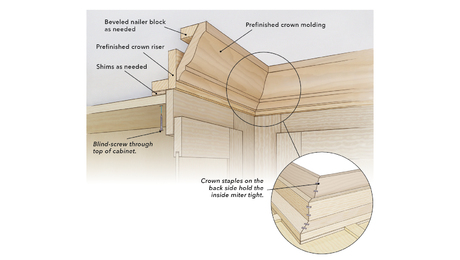*
Can somebody give me an idea about different types of “Turbine Ventilators” available in the market and what factors to consider while selecting one? Also if you can recommend few good brand names ???
Discussion Forum
Discussion Forum
Up Next
Video Shorts
Featured Story

Use these assembly techniques when installing crown risers and molding to minimize visible gaps and nail holes.
Featured Video
Builder’s Advocate: An Interview With ViewrailHighlights
"I have learned so much thanks to the searchable articles on the FHB website. I can confidently say that I expect to be a life-long subscriber." - M.K.
Fine Homebuilding Magazine
- Home Group
- Antique Trader
- Arts & Crafts Homes
- Bank Note Reporter
- Cabin Life
- Cuisine at Home
- Fine Gardening
- Fine Woodworking
- Green Building Advisor
- Garden Gate
- Horticulture
- Keep Craft Alive
- Log Home Living
- Military Trader/Vehicles
- Numismatic News
- Numismaster
- Old Cars Weekly
- Old House Journal
- Period Homes
- Popular Woodworking
- Script
- ShopNotes
- Sports Collectors Digest
- Threads
- Timber Home Living
- Traditional Building
- Woodsmith
- World Coin News
- Writer's Digest


















Replies
*
manohar.. here's one... don't do it..
they're designed for aggie buildings.. but they don't even work good there..
in very windy situations they can seriously depressurize an attic
in no wind situations they do nothing...
use a ridge vent ,like Shingle Vent II,
even mushroom vents would be preferable to turbines
*Manahar. Mike gives good advice. A turbine vent(also called pots in the mid-West) is nothing more than a roof vent with a rotating ventilator cap. These vents ,whether fixed or rotatng, move only a small amount of air only in a small area immediately surrounding the vent.At low wind speeds the turbine vent performs no better or worse than other roof vents.High wind speeds causes excessive spinning which causes excessive wearing of the bearings. They often stick and fail to rotate. Years and years of testing shows they simplyu don't work. Many believe that while the rotsator is turning raoin or snow cannot enter the vent. But just as the rain an d snow enter otehe roof vents it enters the turbine vent. Hundreds of houses in Oklahoma havbe several inches of sand over the attic floor insulation brought in by turbine ventilators.. Turbine vents fail- as do gable end louvered vents--when there is no wind. Hope this helps. GeneL.
*Manohar,Don't do it! The only thing I'll add to the above posts is that if you have several cars up on blocks in your front yard and a couple of used tire planters,decoratively speaking, they will fit right in. But I would still plug them up from the inside and screw the bearings tight.John
*The proper attire for those things is a trash bag and duct tape. Like diapers they require periodic changes as the UV gets to the plastic. Joe H
*Manohar,Ain't it frustrating when you get such conflictin' advice?:-}Rich Beckman
*There is nothing wrong with installing only one turbine vent. If you install more than one, however, you'll notice that they never turn at the same speed, and it'll drive you crazy.
*b "you'll notice that they never turn at the same speed"Now that remark is the kiss of death for anyone wanting a turbine vent.Nicely put though! LOL
*Here comes Mr. Contrary.I put a turbine vent at the back of my garage about 20 years ago. Never oiled it. Never even touched it, that I can remember. Still turns at the slightest breeze. Still dead quiet. Have never seen any indication of any weather getting through it.
*Still ugly.........
*
Can somebody give me an idea about different types of "Turbine Ventilators" available in the market and what factors to consider while selecting one? Also if you can recommend few good brand names ???